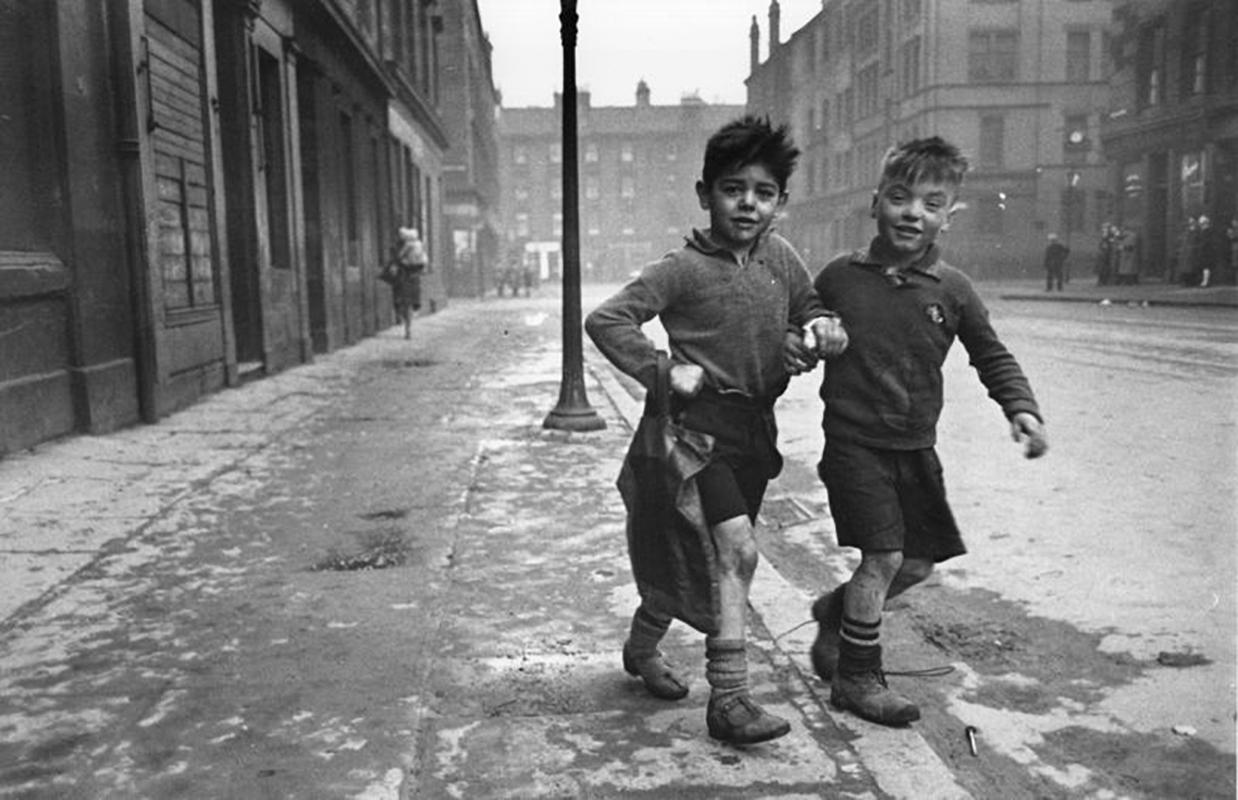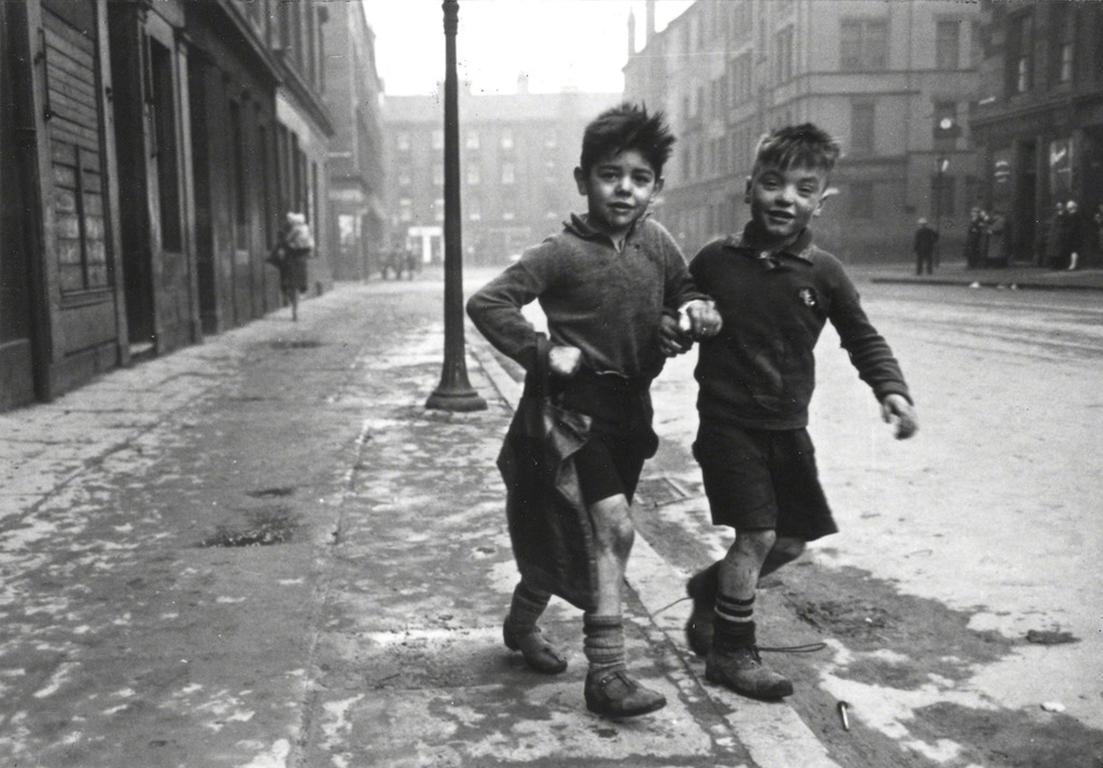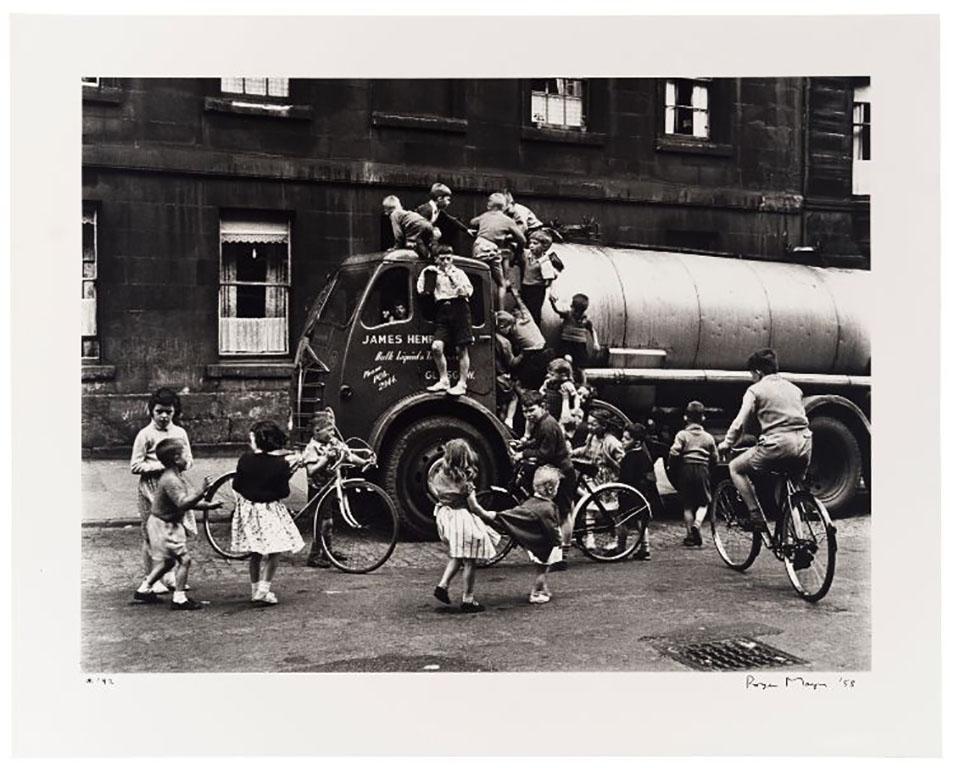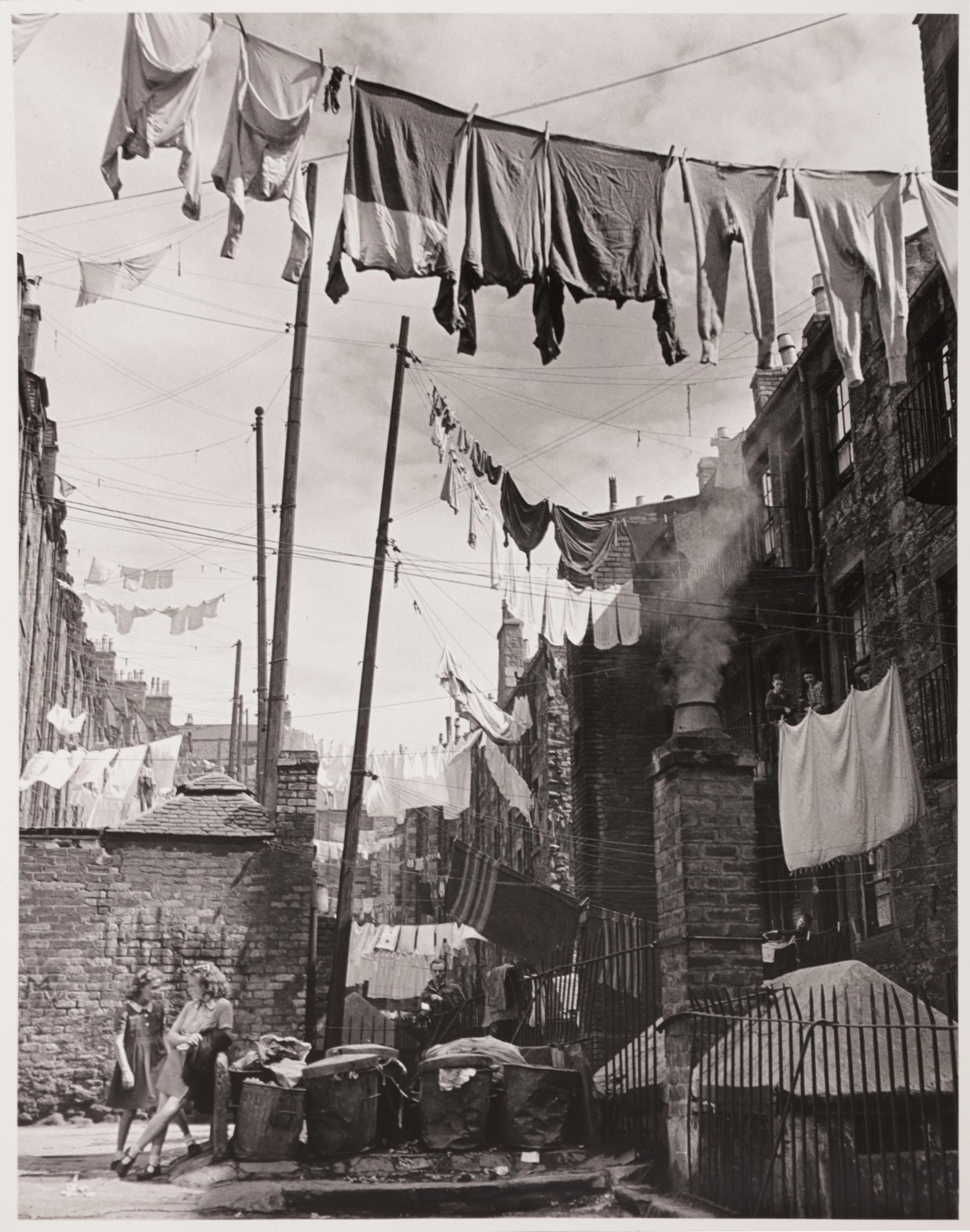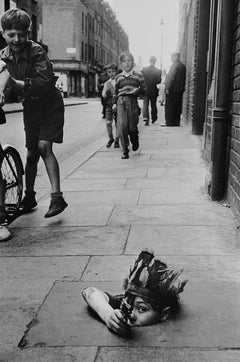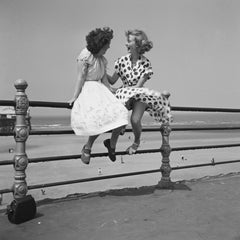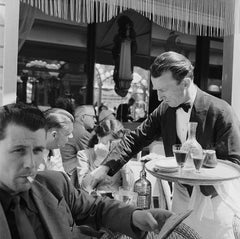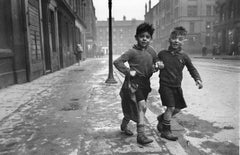Items Similar to Gorbals Boys (1948) - Silver Gelatin Fibre Print
Want more images or videos?
Request additional images or videos from the seller
1 of 5
Bert HardyGorbals Boys (1948) - Silver Gelatin Fibre Print1948 (Printed Later)
1948 (Printed Later)
$1,200
£911.02
€1,042.01
CA$1,676.57
A$1,864.72
CHF 973.70
MX$22,691.61
NOK 12,435.60
SEK 11,662.39
DKK 7,776.93
Shipping
Retrieving quote...The 1stDibs Promise:
Authenticity Guarantee,
Money-Back Guarantee,
24-Hour Cancellation
About the Item
Gorbals Boys (1948) - Silver Gelatin Fibre Print
(Photo by Bert Hardy/Getty Images Archive London)
Possibly Bert Hardy's most famous image.
Two boys in the Gorbals area of Glasgow.
The Gorbals tenements were built quickly and cheaply in the 1840s, providing housing for Glasgow's burgeoning population of industrial workers.
Conditions were appalling; overcrowding was standard and sewage and water facilities inadequate.
The tenements housed about 40,000 people with up to eight family members sharing a single room,
30 residents sharing a toilet and 40 sharing a tap.
By the time this photograph was taken 850 tenements had been demolished since 1920.
Redevelopment of the area began in the late 1950s and the tenements were replaced with a modern tower block complex in the sixties. Original Publication: Picture Post - 4499 - The Forgotten Gorbals - pub. 1948
Additional Information:
Unframed
Paper Size: 20 x 16'' inches / 51 x 41 cm
Printed 2024
Silver Gelatin Fibre Print
Limited edition issued and stamped on front by the Getty Archive London
Edition size 300 only
NOTE OTHER SIZES OF THIS IMAGE AVAILABLE
10 x 8''
10 x 12''
12 x 16''
16 x 20''
20 x 24''
FRAMING AVAILABLE ON REQUEST
Bert Hardy Albert William Thomas Hardy (19 May 1913 – 3 July 1995)
was an English documentary and press photographer
known for his work published in the Picture Post magazine between 1941 and 1957.
Life and work Born in Blackfriars, Bert Hardy rose from humble working class origins in Southwark, London.
The eldest of seven children, he left school at age 14 to work for a chemist who also processed photos.
His first big sale came in 1936 when he photographed King George V and Queen Mary in a passing carriage during the Silver Jubilee celebrations, and sold 200 small prints of his best view of the King.
His first assignment, at age 23, was to photograph Hungarian actor Sakall at the Mayfair Hotel.
Hardy freelanced for The Bicycle magazine, and bought his first small-format 35 mm Leica.
He signed on with the General Photographic Agency as a Leica photographer,
later founding his own freelance firm, Criterion.
General Photographic Agency General Photographic Agency a Fleet Street, London agency, sold photos at least between 1880-1950.
Picture Post and World War II In 1941,
Hardy was recruited by the then editor Tom Hopkinson of the leading picture publication of the 1930s to the 1950s, Picture Post.
Founded in 1938 and funded by publisher Edward Hulton, the magazine's first editor was Hungarian émigré Stefan Lorant (1901–97) assisted by Hopkinson, who took over as editor from 1940. The picture-centric, left-leaning and reasonably-priced publication was highly successful and circulation soon rose to over a million.
Hardy's photographer colleagues included Felix H. Man (aka Hans Baumann), John Chillingworth, Thurston Hopkins, Kurt Hutton, Leonard McCombe, Francis Reiss, Humphrey Spender, Grace Robertson and Bill Brandt, who went out with the writers on stories together, working as colleagues, not competitors.
Hardy was self-taught and used a Leica—unconventional gear for press photographers of the era—
but went on to become the Post's Chief Photographer, after he earned his first photographer credit for his 1 February 1941 photo-essay about Blitz-stressed fire-fighters.
Hardy served as a war photographer in the Army Film and Photographic Unit (AFPU) from 1942 until 1946: he took part in the D-Day landings in June 1944; covered the liberation of Paris; the allied advance across the Rhine; and was one of the first photographers to enter the liberated Belsen to record the suffering there. He also saved some Russian slaves from a fire set by German police in the city of Osnabrück, before photographing the aftermath. Near the end of World War II, Hardy went to Asia, where he became Lord Mountbatten's personal photographer. He later went on to cover the Korean War along with journalist James Cameron for Picture Post, reporting on atrocities committed by Syngman Rhee's police under the United Nations flag at Pusan in 1950, and later on that war's turning point, the Battle of Inchon, photojournalism for which he won the Missouri Pictures of the Year Award, "obtaining pictures of the landing at Inchon as, unlike other members of the press, Hardy could shoot 1/15 sec at fl.5 with his Leica miniature".
Late career Hardy stayed on until Picture Post ceased publication in June 1957. It succumbed to the rise of television and falling circulation, and its increasingly unpopular identification with Labour's 'New Britain' and 'Fair Shares for All'; the party being defeated in the 1951 election.[15] There being no other outlets for photojournalists, Hardy became an advertising photographer before giving the medium up altogether to become a farmer in 1964. Recognition Three of Hardy's photos were used in Edward Steichen's famous The Family of Man exhibition and book; two were taken in Burma, including one of a monk at his desk in deep thought. Another shows a young couple, much in love and relaxing by the window of a tiny basement flat, photographed for part of a feature in Picture Post magazine, 'Scenes From The Elephant', published 8 January 1949, on everyday life in the Elephant and Castle district of South London. According to Hardy, the man in that portrait was a Canadian recently released from prison who had just spent a night with the prostitute in the photographer's image. One of his most famous, and Hardy long claimed his favorite, photo, shows two street urchins off on a lark in Gorbals, an image which has come to represent Hardy's keenest documentary skill. He said he liked it so much because it represented his own rough-and-tumble upbringing, with Glasgow's Gorbals very much resembling London's Elephant & Castle District. Hardy himself was photographed many times, including during the war; three very good photo-portraits of him are currently in the Photographs Collection of the National Portrait Gallery. Having written an article for amateur photographers suggesting that you didn't need an expensive camera to take good pictures, Hardy staged a carefully posed photograph of two young women sitting on railings above a breezy Blackpool promenade using a Box Brownie in 1951, a photograph which has since become an iconic image of post-war Britain. Just before Picture Post closed, Hardy took 15 photos of the Queen's entrance at the Paris Opera on 8 April 1957, which were assembled as a photo-montage by the magazine's technicians. It was one of the most challenging photo-montages ever created, because there were a sizeable live crowd, guards, and other dignitaries, in front of his camera. After leaving Picture Post Hardy became one of the most successful advertising photographers until his retirement in 1964 to his farm in Oxted. His second wife, Sheila, was a photo researcher for Picture Post and still holds the copyright to his private collection of photos; Getty Images holds the copyright to his Picture Post works. A memorial plaque honouring him is in the journalists' church, St Bride's, Fleet Street, London. In October 2008, London Borough of Southwark unveiled a Blue Plaque on Bert Hardy's family home at The Priory, Webber Street, Southwark. The plaque was erected following a popular vote.
- Creator:Bert Hardy (1913-1995, British)
- Creation Year:1948 (Printed Later)
- Dimensions:Height: 20 in (50.8 cm)Width: 16 in (40.64 cm)
- Medium:
- Movement & Style:
- Period:
- Framing:Framing Options Available
- Condition:
- Gallery Location:London, GB
- Reference Number:Seller: SM241stDibs: LU44937536562
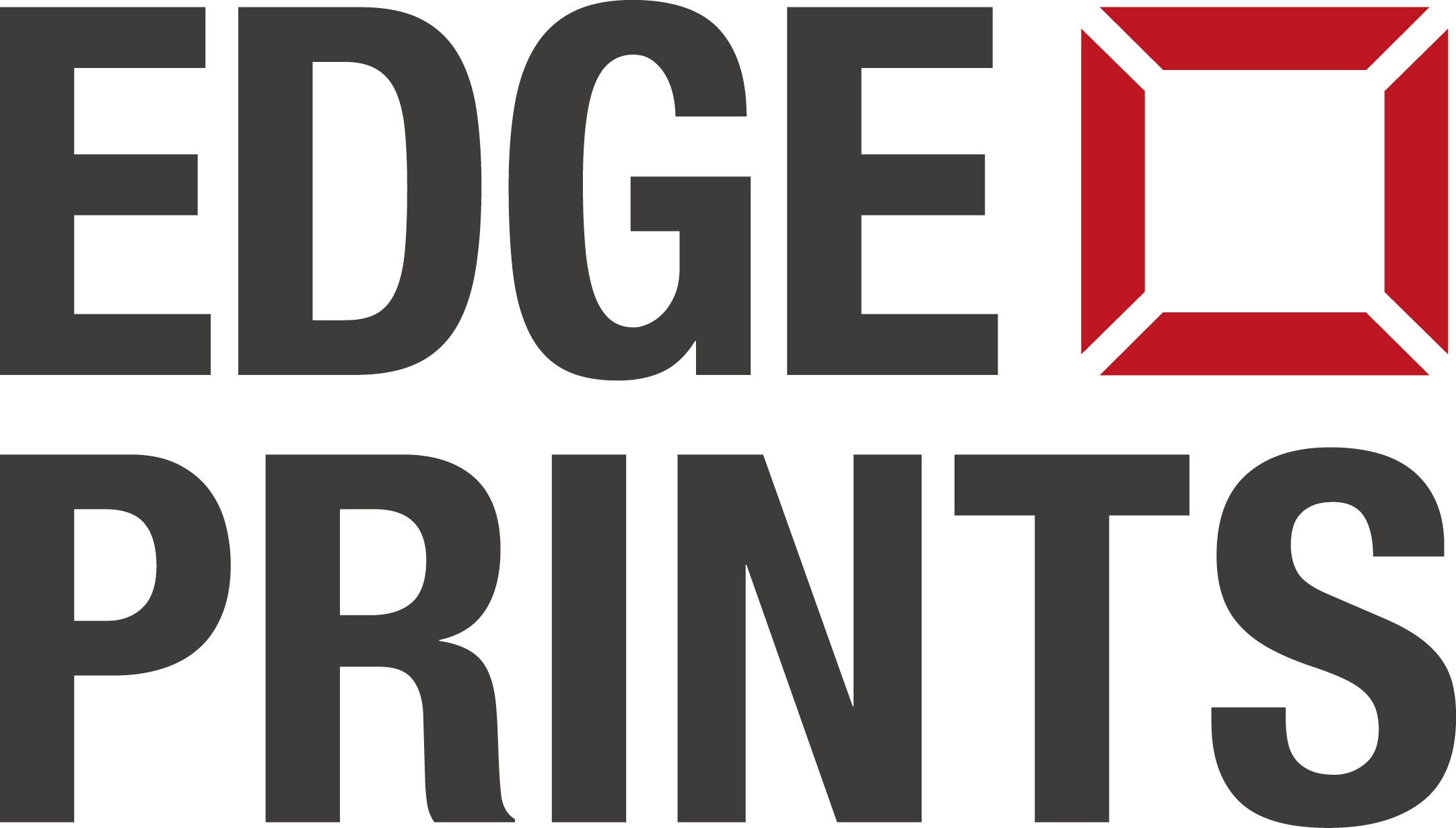
About the Seller
4.9
Platinum Seller
Premium sellers with a 4.7+ rating and 24-hour response times
Established in 2011
1stDibs seller since 2016
513 sales on 1stDibs
Typical response time: 1 hour
- ShippingRetrieving quote...Shipping from: London, United Kingdom
- Return Policy
Authenticity Guarantee
In the unlikely event there’s an issue with an item’s authenticity, contact us within 1 year for a full refund. DetailsMoney-Back Guarantee
If your item is not as described, is damaged in transit, or does not arrive, contact us within 7 days for a full refund. Details24-Hour Cancellation
You have a 24-hour grace period in which to reconsider your purchase, with no questions asked.Vetted Professional Sellers
Our world-class sellers must adhere to strict standards for service and quality, maintaining the integrity of our listings.Price-Match Guarantee
If you find that a seller listed the same item for a lower price elsewhere, we’ll match it.Trusted Global Delivery
Our best-in-class carrier network provides specialized shipping options worldwide, including custom delivery.More From This Seller
View All"Street Games" by Thurston Hopkins
By Thurston Hopkins
Located in London, GB
"Street Games" by Thurston Hopkins
A young child wearing an Indian headdress hides in a coal hole as he takes aim under the watchful eye of a friend....
Category
1950s Modern Black and White Photography
Materials
Black and White
Blackpool Railings (1951) - Silver Gelatin Fibre Print
By Bert Hardy
Located in London, GB
Blackpool Railings (1951) - Silver Gelatin Fibre Print
(Photo by Bert Hardy / Getty Images Archive London)
Two women chatting on the railings in B...
Category
1940s Modern Landscape Photography
Materials
Black and White, Silver Gelatin
Cafe Culture by Bert Hardy Limited Edition Giant Oversize Silver Gelatin Print
By Bert Hardy
Located in London, GB
"Cafe Culture" by Bert Hardy
A waiter serving clients on the terrace of a cafe on the Champs-Elysees, Paris, June 1951.
Original publication: Picture Po...
Category
1950s Modern Black and White Photography
Materials
Black and White
Cafe Culture by Bert Hardy Limited Edition Giant Oversize Silver Gelatin Print
By Bert Hardy
Located in London, GB
"Cafe Culture" by Bert Hardy
A waiter serving clients on the terrace of a cafe on the Champs-Elysees, Paris, June 1951.
Original publication: Picture Post - 5343 - Sunday Morning I...
Category
1950s Modern Black and White Photography
Materials
Black and White
Last Bus In London by Bert Hardy - Limited Edition silver gelatine print
By Bert Hardy
Located in London, GB
Last Bus In London by Bert Hardy
Limited Edition silver gelatine print
A couple saying goodbye on a bus in Shaftesbury Avenue in London, July 1953 .
Original Publication: Picture Post - 6576 - Known Your Piccadilly - pub. 4th July 1953
(Photo by Bert Hardy/Picture Post/Hulton Archive/Getty Images Archive London England)
Paper size 12x16 inches / 31 x 41 cm
Produced utilising the original negative
Numbered and stamped by the Getty Archive London
Limited edition to 300 only
Silver gelatine fibre based baryta paper print
Certificate of authenticity included
printed 2024
Ships securely from London.
Other sizes and Framing available on request.
Bert Hardy
Bert Hardy
Albert William Thomas Hardy (19 May 1913 – 3 July 1995) was an English documentary and press photographer known for his work published in the Picture Post magazine between 1941 and 1957.
Life and work
Born in Blackfriars, Bert Hardy rose from humble working class origins in Southwark, London. The eldest of seven children, he left school at age 14 to work for a chemist who also processed photos. His first big sale came in 1936 when he photographed King George V and Queen Mary in a passing carriage during the Silver Jubilee celebrations, and sold 200 small prints of his best view of the King. His first assignment, at age 23, was to photograph Hungarian actor Sakall at the Mayfair Hotel. Hardy freelanced for The Bicycle magazine, and bought his first small-format 35 mm Leica. He signed on with the General Photographic Agency as a Leica photographer, later founding his own freelance firm, Criterion.
General Photographic Agency
General Photographic Agency a Fleet Street, London agency, sold photos at least between 1880-1950.
Picture Post and World War II
In 1941, Hardy was recruited by the then editor Tom Hopkinson of the leading picture publication of the 1930s to the 1950s, Picture Post. Founded in 1938 and funded by publisher Edward Hulton, the magazine's first editor was Hungarian émigré Stefan Lorant (1901–97) assisted by Hopkinson, who took over as editor from 1940. The picture-centric, left-leaning and reasonably-priced publication was highly successful and circulation soon rose to over a million. Hardy's photographer colleagues included Felix H. Man (aka Hans Baumann...
Category
1950s Modern Figurative Photography
Materials
Silver Gelatin
Students of Harrow School (1929) - Silver Gelatin Fibre Print
Located in London, GB
Students of Harrow School (1929) - Silver Gelatin Fibre Print
(Photo by Imagno/Getty Images)
Students of Harrow School are returning to school after Christmas vacations...
Category
1920s Modern Portrait Photography
Materials
Black and White, Silver Gelatin
You May Also Like
'Gorbals Boys' Silver Gelatin Print (Limited Edition)
By Bert Hardy
Located in London, GB
'Blackpool Railings' Oversize Silver Gelatin Print (Limited Edition)
Now widely recognised as a Master of Photography - this is considered to be o...
Category
1950s Modern Black and White Photography
Materials
Silver Gelatin
'Gorbals Boys' Bert Hardy Limited Edition Silver Gelatin Fibre Print
By Bert Hardy
Located in London, GB
'Gorbals Boys' (1948)
by Bert Hardy
Limited Edition 44/300
Silver Gelatin Fibre Print
Paper size 10 x 12 inches
Printed later
Two boys in the Gorbals area of Glasgow. The Gorbal...
Category
Mid-20th Century Realist Black and White Photography
Materials
Silver Gelatin
The Gorbals Boys, Glasgow - Bert Hardy (Black and White Photography)
By Bert Hardy
Located in London, GB
The Gorbals Boys, Glasgow - Bert Hardy (Black and White Photography)
Signed on front, stamped with photographer's copyright ink stamp on reverse
Silver gelatin print, printed later
1...
Category
1940s Black and White Photography
Materials
Silver Gelatin
The Boys, Montreuil – Paris 1962: Christer Strömholm’s Most Iconic Photograph
Located in Stockholm, SE
Among Christer Strömholm’s most iconic images is Pojkarna, taken in the Paris suburb of Montreuil in 1962. Two small boys, one curious and leaning i...
Category
2010s Black and White Photography
Materials
Pigment
Children Around a Lorry, Cowcaddens, Glasgow, 1958 - Roger Mayne
By Roger Mayne
Located in London, GB
Signed and dated
Signed, titled, dated and numbered on reverse
Silver gelatin print, printed 1992
12 3/4 x 17 inches
Roger Mayne (1929-2014) is a British photographer known for his series documenting the children of Southam Street, West London. Influenced as much by the St Ives school of artists as by his photographer contemporaries, Mayne consciously printed with high contrast to emphasise the formal qualities of his work and increased the scale of his prints to pursue a dialogue with contemporary painting.
The images which Roger Mayne captured between 1956 and 1961 at Southam Street, London represent the most significant personal and professional project of his career. At that time, Southam Street in North Kensington had changed little since Victorian times and was later declared uninhabitable, making way for Erno Goldfinger...
Category
Mid-20th Century Photography
Materials
Silver Gelatin
Washing Strung Between the Tenements, Dundee, Scotland, 1946
By Wolfgang Suschitzky
Located in Middletown, NY
Silver gelatin print, printed 1980s; image dimension 15 x 11 5/8 in. (380 x 293 mm), sheet dimension, 15 3/8 x 12 1/8 in. (390 x 309 mm). The verso signed "W. Suschitzky" in black crayon, titled and dated Dundee. 1946".
[Michael Omasta, et al. Wolf Suschitzky: Seven Decades of Photography (Vienna: Synema, 2014), ill. p. 188].
A photograph that attests to Suschitzky's keen interest in the social environments of the working class. His worked as a cinematographer brought him to Britain’s coal mining communities, to the steel mills and the workers' housing. "In Dundee I came across the worst slums I had ever seen. When I took this picture I was next to a ten story high tenement building. There was only one toilet on each floor and one cold water tap...
Category
Mid-20th Century Modern Black and White Photography
Materials
Silver Gelatin
